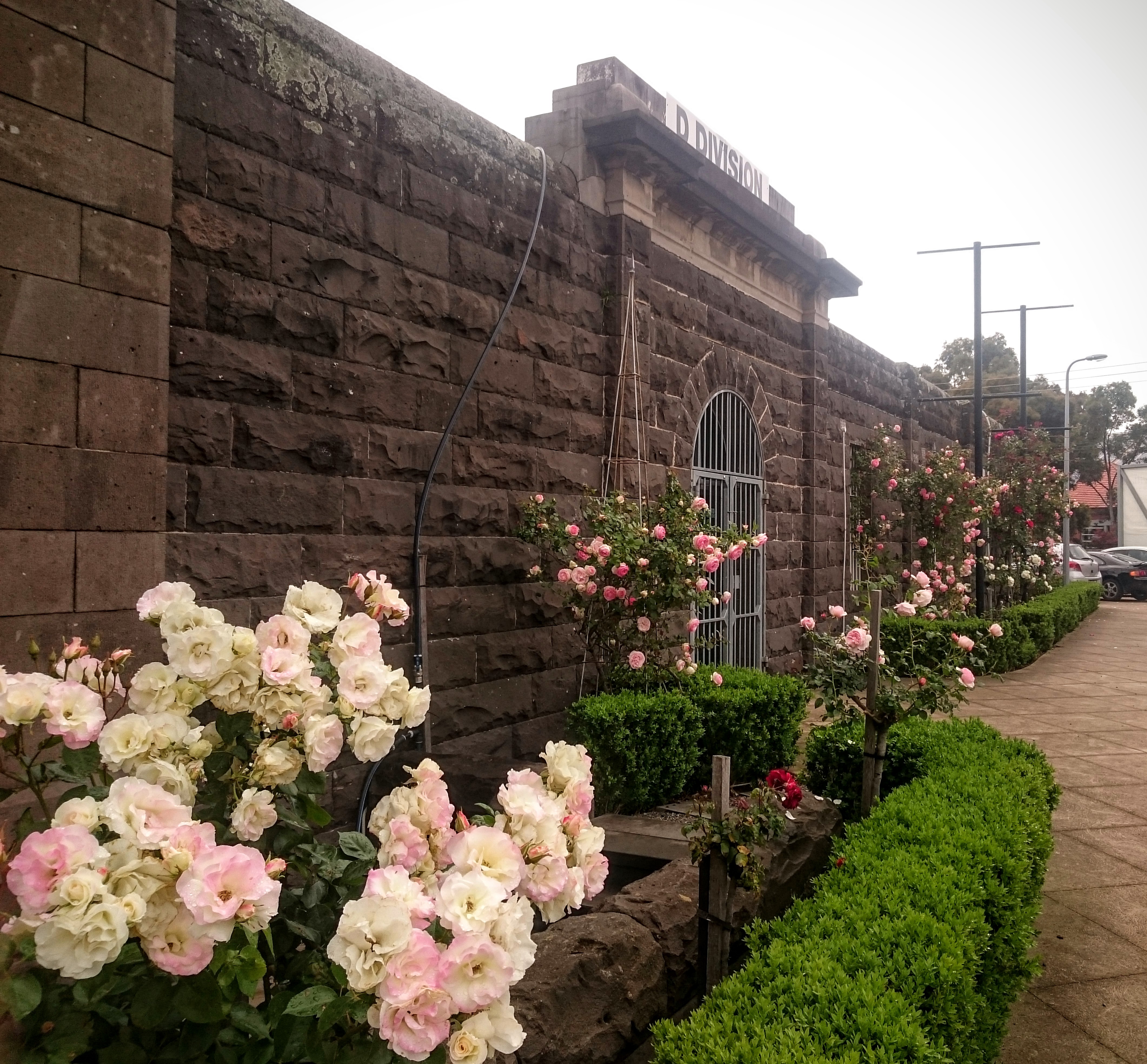Starting a Community Garden is Not a One-Man Show
An interview with Andrew Ogbourne about setting up a community garden within the famous Pentridge Prison and why new residential areas shouldn't be just a collection of houses.
Her Majesty’s Prison Pentridge was established in 1851, in Coburg in Melbourne’s inner north. When it ceased to serve its original purpose and was closed in 1997, it became an attractive area for new development. In 2016, a group of residents got together with the idea of establishing a community garden within the famous Pentridge bluestone walls. They imagined a garden in which local residents could get together to grow fruit and vegetables and connect with other community members. Since that time, Shayher Group, the major developers of Pentridge, have provided a fantastic plot of land and the community group has developed a design and commenced the daunting task of raising funds, developing partnerships with local businesses and building the garden.

In September, you’ll be launching a new community garden. How long has the process taken from having the idea of setting up a garden to launching it?
Close to 12 months so far. That’s a very short time for a new community garden because many groups spend the first year or two just finding a piece of land. We have been very fortunate in getting access to a site provided by the Pentridge developers.
Have you had any previous experience with starting a community garden or a similar community project?
Not at all. I’ve done a lot of my own gardening but a community garden is a completely different proposition. So, I've drawn on the experience of other local community groups and businesses to help me. Moreland Community Gardening (who run the West Brunswick garden) in particular have been extremely helpful.
What kind of expertise or specific skills have you needed so far in regards to the planning and design of the garden?
I’ve done a lot of my own gardening over the years. That means I know about compost, plant nutrition, crop rotation etc. I have also been involved with School P&C associations—another kind of community group. However, I had almost no experience of community gardens and absolutely no experience of establishing a new one. So, I have found it very important to both build a group of local community members who have complementary skills and build close contact with other local community gardens.
The whole site has a very interesting history. Has this reflected in the development of the garden in any way? Were there any requirements you had to meet due to its historic nature?
There is a Master Plan governing the overall layout and use of the Pentridge site. It determines what will be built where over the coming years and makes sure the site’s historical values are not only retained but celebrated. It provides a great context and sets principles that we can embrace without telling us what we can and can’t do in the garden.

There is a Master Plan governing the overall layout and use of the Pentridge site. It determines what will be built where over the coming years and makes sure the site’s historical values are not only retained but celebrated.
So, in designing the garden, we are aiming to follow the lead of the Master Plan. The garden site is right next to one of the old Pentridge walls on the corner of Murray Road and Stockade Avenue. It's great to have not only the wall but one of the recently restored guard towers on one border of the garden. We will be making use of some of the recycled bluestone from the site within the garden as seating and features here and there.
How many people were involved in the planning phase and what were their roles?
My role has been to get the ball rolling by floating the idea and whipping up enthusiasm for it with the Council, Shayher Group and local community members.
A lot of people have been involved in the journey so far and that will increase over the next year. My role has been to get the ball rolling by floating the idea and whipping up enthusiasm for it with the Council, Shayher Group and local community members. Moreland Community Gardening have been extremely helpful and supportive all along. We have established the Pentridge Garden as a second garden (after West Brunswick) within Moreland Community Gardening Inc, which reduces the amount of administration we have to do.
Kieran Dickson has been incredible in helping us design the garden itself. He has immense experience in designing and working in community gardens. He relished the chance to help the local community group design and build a garden that expresses the vision that a group of passionate but naive locals had in mind.
Mark Sanders has been our “mentor” in both encouraging us and helping us avoid some of the traps we might otherwise have hit in things like funding and the organising of volunteers. Mark has also been a constant source of invaluable connections around the community.
A group of passionate locals have formed the Organising Committee for the Pentridge garden. Jo Stavers, Natalie Ryan, Patricia Niklas, Belinda Bos, Russell Richard and Kat Dibb have worked tirelessly over the past 6 months to turn a dream into something that is starting to look like a real garden. Jo is now the convenor of the PCG Organising Committee.
The Moreland Councillors have been very supportive of the garden idea. Natalie Abboud and Sue Bolton in particular have provided encouragement, contacts and support in the early stages.
Finally, a number of local businesses have already provided their support to the project. Nelson Alexander, Bunnings, the Green Centre, Rocke Brothers and Bullen Art and Garden have all made generous donations to the garden. We are, of course, working to expand our sponsorship through partnerships with other businesses.
What do you think are the key factors that make a community garden a place that people keep returning to?
There are two main factors, I think. As city populations grow, we build more medium and high density housing with very little space of our own in which to garden or just enjoy the outdoors. We can’t keep building out into the surrounding farmland, so this trend can only continue. Community gardens, working alongside parks and other spaces provide a way for people to remain connected with the environment by growing some of their own fruit and vegetables close to home.
Most importantly, they form a community of connected people who care about each other and the neighbourhood and garden they live in. The community-building is something that people in cities are crying out for, even if they don’t articulate it in those terms.
The second factor is perhaps even more powerful. Community Gardens are a place where people can come together in a peaceful space within the hard urban environment. They meet neighbours they might otherwise barely know; they work together on building something important; they learn from each other; they grow food to feed themselves; and they chat over a cup of tea. Most importantly, they form a community of connected people who care about each other and the neighbourhood and garden they live in. Community-building is something that people in cities are crying out for, even if they don’t articulate it in those terms.
It’s not very common that a property developer considers setting up a community garden as part of the development project. How did you convince the Shayher Group that setting up a community garden would be a good decision?
I didn’t have to do much convincing actually. The Shayher Group knows that, to succeed, the Pentridge development must be more than a collection of apartments that people live in. It must become a community precinct that residents want to stay in and people from surrounding areas want to visit. That means it needs commercial and community activities - and a sense of community. The Shayher people were very quick to see that a community garden contributes to Pentridge achieving that aim and so were very keen to support the idea.
What does the garden look like now and what are you planning to grow there?
The garden is at a very early stage and right now it is more open ground than garden. Having recently completed the design, we have marked out the garden layout on the ground and started building the first garden elements.
Our compost system is the first working garden element. We are collecting scraps from local residents both by word of mouth and via ShareWaste. Reground have been delivering coffee grounds collected from local cafes and we are also reusing sawdust from a local timber miller. We have established the first ornamental bed to welcome visitors to the garden—it will burst into bloom this coming spring. We also have a shed (formerly a 20-foot shipping container) that we are in the process of painting with an inspiring mural. The first fruit trees in containers will be planted in early September and we hope to have the first vegetables ready for planting at around the same time.
We have made a lot of progress but have much more ahead of us before we can say we have a mature garden. The skeleton is there—we just need volunteers to help us make it happen and donations and sponsorship from anyone and everyone to allow us to buy the supplies that will make an idea a reality.
We wish you a lot of delicious produce and many happy gardeners!